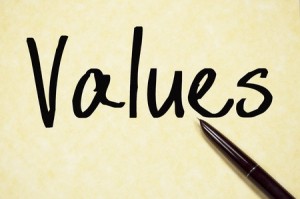How Values Help Leaders Impact Culture
Every organization has a culture. It could be viewed as good or bad, but the fact is it exists.
To identify the type of culture that is present in an organization, assess what the leaders value. Ideally, what the leaders value map to the stated values that are clearly defined. In addition, the decisions and behaviors of the leaders support these values.
This is what makes for a great organization.
 Jim Collins is someone who really understands this concept. In his books Built to Last
Jim Collins is someone who really understands this concept. In his books Built to Last and Good to Great, Collins outlines the results of his research with great clarity: values matter.
“Core Values are essential for enduring greatness, but it doesn’t seem to matter what those core values are. The point is not what core values you have, but that you have core values at all, that you know what they are, that you build them explicitly into the organization, and that you preserve them over time.” – Jim Collins
Surprisingly, few organizations have stated values. The reason for this problem is straightforward: it’s a leadership issue.
Leaders have the responsibility to identify and define an organization’s values. Sometimes, this requires a little encouragement.
Convincing leaders that values matter
 If you work in an organization that doesn’t have stated values, what can be done to convince the leaders that values matter? Highlight four key benefits:
If you work in an organization that doesn’t have stated values, what can be done to convince the leaders that values matter? Highlight four key benefits:
- Values set strategic direction. They ensure that all stakeholders understand what is produced or provided, how it gets done, who is involved, where it belongs, and when and why it matters.
- Values define expected behavior. These are the guiding principles of the organization, outlining what is acceptable and not acceptable. They set the criteria for who to hire and when to fire or reprimand.
- Values build competitive differentiation. Well-defined Differentiating Values highlight what is truly unique about an organization. They outline a meaningful purpose. They also increase brand value.
- Values empower leaders to simplify and focus. Whether someone leads 10 or 10,000 people, clearly defined values help leaders cut through the maze of issues and get everyone aligned around the top priorities.
Now, what if an organization does have stated values but the culture is not aligned with them? This again is a leadership issue.
Aligning culture and values
I’m often asked: “What’s the difference between values and culture?” Here’s my response:
Relevant and meaningful values set the strategic direction of an organization, and influence the culture by establishing expected behaviors.
The opposite is not true.
When the stated values of an organization are unique, relevant, and sustainable, AND decisions and behaviors support these values, then values and culture are aligned.
But if decisions and behaviors occur that are not aligned with the values, then alignment has not yet been achieved. When misalignment persists, employees (and customers) view the stated values as fake and thereby worthless.
So what’s the solution?
Leaders should consider the following four ways to align (or re-align) culture and values:
- Ubiquitous integration. Values need to be integrated into every level of the organization, from C-Level executives to sales, marketing, operations, HR, and even contractors and suppliers. Values also need to be incorporated into the hiring process, as well as the guidelines for firing or reprimanding.
- Hold people accountable. The best way to support alignment is to encourage employees to keep each other accountable (i.e. where one employee says to another “You might like to do that, but you can’t do that here!”). Leaders then need to acknowledge and reward good behavior, and correct or reprimand bad behavior when someone violates the stated values. Note: this applies to the leaders as well!
- Communicate everywhere. The values need to be highlighted through multiple mediums, including the organization’s
- website, especially on the About page and Careers page
- code of Business Conduct document(s)
- annual Report
- corporate Sustainability Reports
- employee handbooks and onboarding documents
- posters in meeting rooms to remind everyone of the stated values
- Make values visible externally. Incorporate the values in the organization’s marketing and promotional activities, specifically in the messaging. This way not only employees know what ‘s expected of them, but customers know what to expect as well (e.g. how Volvo Trucks promotes it’s key differentiating value of safety).
Bottom line: It’s a leaders job to identify and define their organization’s values AND align culture with these values. This not only ensures everyone is focused on the same priorities, it also leads to enduring greatness.









